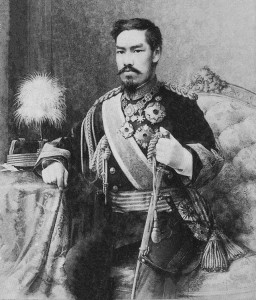Japan’s Meiji Restoration
Thursday, November 9th, 2017November 9, 2017
Today, November 9, marks the 150th anniversary of the Meiji Restoration that ended centuries of shogun rule in Japan. On Nov. 9, 1867, the last leader of the Tokugawa Shogunate (warrior government) resigned and returned sole authority in Japan to the imperial family. Emperor Meiji (1852-1912) then reigned in Japan until his death. Meiji means enlightened rule, and the period of the emperor’s reign was known as the Meiji era. During the Meiji era, Japan began to develop as an international industrial and military power.
In 1192, the emperor gave the title shogun (great general) to the military leader Yoritomo of the Minamoto family. Yoritomo established a bakufu or shogunate in Kamakura in eastern Japan. The Kamakura bakufu, which lasted until 1333, shared civil and military rule with the imperial court at Kyoto. The Ashikaga family, a branch of the Minamoto family, established a bakufu in the Muromachi district of Kyoto in 1338. The Ashikaga shoguns proved unable to maintain control. This period was marked by battles among the warrior class, called samurai. In 1603, Ieyasu of the Tokugawa family founded the most powerful bakufu, in Edo (now Tokyo). Tokugawa authority lasted until 1867.
The emperor gained the throne as the result of a revolution known as the Meiji Restoration. Nobles, military lords called daimyo, and samurai had forced the shogun out of power. The leaders of the revolution and their successors were the real rulers during the Meiji era. In the emperor’s name, they carried out many reforms. They organized a modern army and navy, created a system of public education, promoted industrial development, and built modern systems of transportation and communication.
Under Emperor Meiji, Japan began to expand its influence. It won wars against China in 1895 and Russia in 1905. In 1910, Japan made Korea a colony. After forming an alliance with the United Kingdom in 1902, Japan gained international recognition as an equal of the Western powers.
The emperor, whose given name was Mutsuhito, was born on Nov. 3, 1852, in Kyoto. He died on July 30, 1912. In keeping with the practices of Japan’s Shinto religion, he was enshrined as a god after his death.



